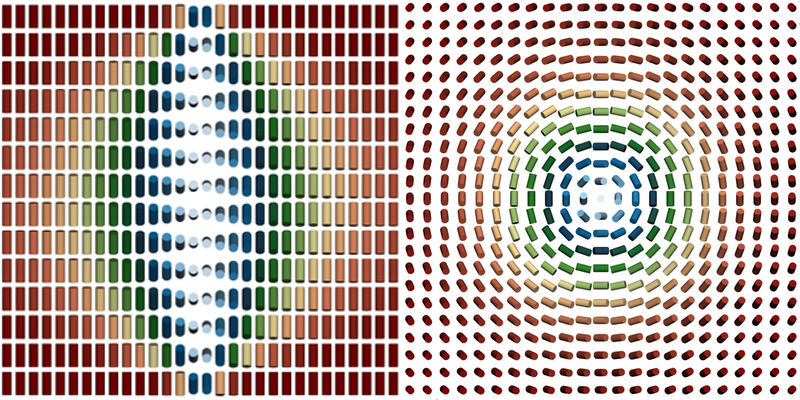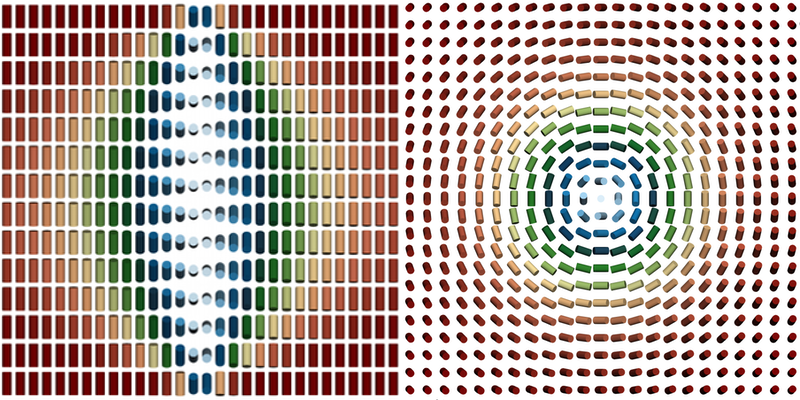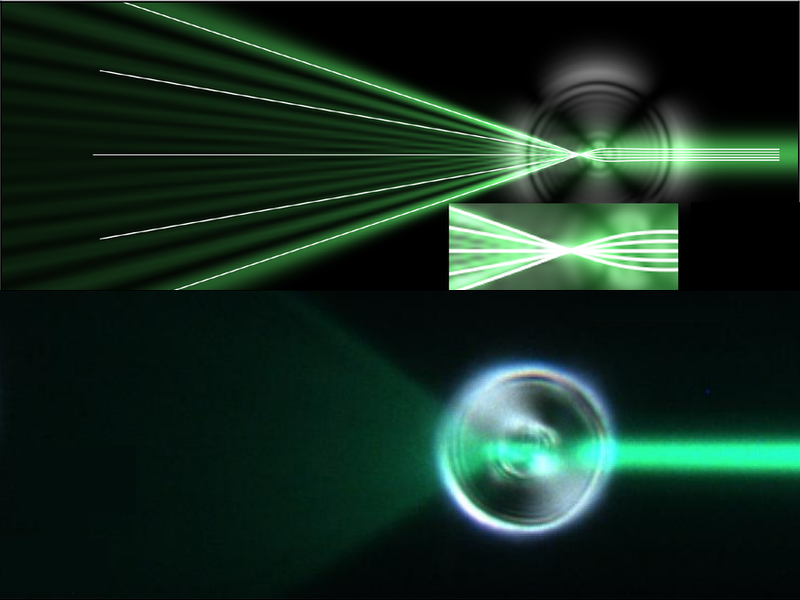Liquid-Crystal Vortices Focus Light
Liquid crystals are famous for controlling light in flat-screen displays, usually when the crystal has its rod-shaped molecules aligned. Now researchers have shown that twirling patterns of the molecules can also interact with light, anticipating that such patterns could be the basis for all-optical computing [1]. Their experiments show that arrangements called topological solitons—which can be rapidly reconfigured with external fields—can bend a laser beam or focus its light. Thus, the researchers say, solitons could be used to create optical logic gates or optical transistors.
In liquid-crystal displays (LCDs), the molecules typically line up in perfect rows whose order strongly influences light traveling through the material (see Focus: A Faster Liquid Crystal). But liquid-crystal molecules can also arrange in a variety of other patterns that could be useful for devices. Solitons are a class of patterns that include wave-like motifs, such as the twist wall—a structure where each layer of molecules is rotated with respect to the next layer, so that they execute a 180∘ rotation over a short distance. In another soliton called a skyrmion, the wave spirals out from a central point, forming a twirling pattern that looks like a vortex. Researchers first observed a soliton in a liquid crystal 50 years ago, but it was unclear whether and how these structures might interact with light.
To find out, Andrew Hess at the University of Colorado Boulder and his colleagues aimed lasers at solitons. To create the solitons, the team used a previously-demonstrated method that involves sandwiching a thin layer of a liquid crystal between two glass plates and then hitting the material with a laser to induce a pattern [2]. By moving the laser and applying a voltage across the plates, the researchers produced twist walls and skyrmions of various sizes. Next, the team sent in a lower-power laser beam that ran parallel to the glass plates. They then used an optical microscope to observe this beam’s interactions with the solitons.
Hess and his colleagues saw two main behaviors when light hit the solitons: bending and focusing. The bending happened for both solitons, while the focusing occurred only for skyrmions and only when the laser beam passed through a skyrmion’s central point.
The team explained the behavior theoretically by hypothesizing that the solitons locally alter the material’s refractive index—essentially the speed of light in the material. This alteration causes the soliton to act like the interface between two materials with different refractive indices, like air and water. The team found that a generalized version of Snell’s law—the textbook rule that dictates the angle at which light is reflected or refracted when it hits an interface—predicted the light paths.
Hess says that the findings show that these solitons interact with light and thus could spur the development of new types of displays or new kinds of optical devices made solely from liquid crystals. For example, one could imagine making some sort of circuit board in a liquid crystal where the solitons bend and manipulate the light to do a calculation. That possibility is exciting, says Teresa Lopez-Leon at ESPCI ParisTech. Lopez-Leon envisions being able to use a series of the solitons inside the same liquid-crystal layer to create interconnected, optically-active devices. “These optical elements would have no physical boundaries and could be reconfigured and manipulated by external fields, which could lead to all-optical devices with unprecedented adaptability and versatility,” she says.
–Katherine Wright
Katherine Wright is the Deputy Editor of Physics Magazine.
References
- A. J. Hess et al., “Control of light by topological solitons in soft chiral birefringent media,” Phys. Rev. X 10, 031042 (2020).
- P. J. Ackerman et al., “Optical generation of crystalline, quasicrystalline, and arbitrary arrays of torons in confined cholesteric liquid crystals for patterning of optical vortices in laser beams,” Phys. Rev. E 86, 021703 (2012).






